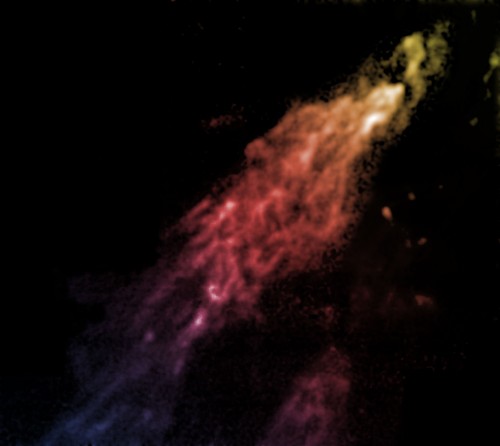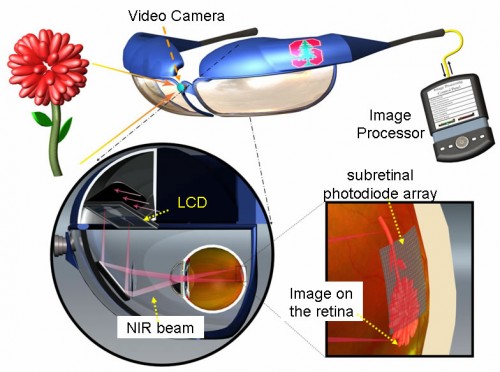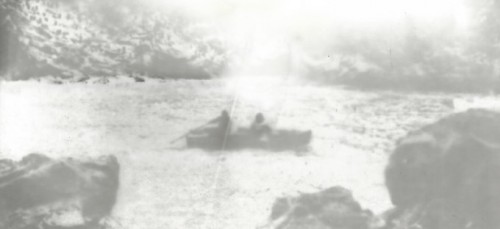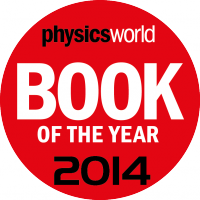Posts by: Margaret Harris
Coming soon(ish) to a galaxy near you

Image of Smith’s Cloud taken by the Green Bank Telescope. (Courtesy: Bill Saxton, NRAO/AUI/NSF)
By Margaret Harris at the AAAS meeting in San Jose
A giant cloud of hydrogen gas is barrelling towards the Milky Way faster than the speed of sound, and dark matter may hold it together long enough to produce a spectacular outburst of new stars in the night sky – but not for another 30 million years.
The cloud – which is known as Smith’s Cloud after Gail Bieger-Smith, who discovered it as an astronomy student in 1963 – is one of several starless blobs of hydrogen known to exist in the space between galaxies. According to Felix “Jay” Lockman, principal scientist at the US National Radio Astronomy Observatory’s Green Bank Telescope, such gas clouds are, in effect, “construction debris” left over from an earlier age of galaxy formation. “These are parts for remodelling your house that didn’t arrive by the time the contractor left,” Lockman told an audience at the 2015 AAAS meeting in San Jose, California.
A sight for blind eyes

A schematic of the prosthetic vision system developed by Daniel Palanker. (Courtesy: Daniel Palanker)
By Margaret Harris at the AAAS meeting in San Jose
“Restoration of sight to the blind” is a brave claim, one with an almost Biblical ring to it. For Daniel Palanker, though, it is beginning to look as if it is an achievable goal. A medical physicist at the University of Stanford, Palanker has developed a prosthetic vision system that replaces damaged photoreceptors in the retina with an array of tiny photodiodes. When infrared images are projected onto this array, the photodiodes convert the light pulses into electrical signals, which are then picked up by the neurons behind the retina and transmitted to the brain. The result is an artificially induced visual response that, while not as good as normal vision, could nevertheless provide “highly functional restoration of sight” to people with conditions such as retinitis pigmentosa or age-related macular degeneration (AMD).
Photonics by the Bay
By Margaret Harris in San Francisco
The International Year of Light is a global celebration, but right now, it’s definitely got its heart in San Francisco. For the past five days, experts in optics, lasers and biomedical imaging have been converging on the “city by the bay” for the annual Photonics West conference, and I’ve joined them in order to learn more about the hot topics in optical science.
View all posts by this author | View this author's profile
Oppenheimer and the Bomb
By Margaret Harris
It’s pretty easy to see why the Royal Shakespeare Company (RSC) wanted to stage a play about J Robert Oppenheimer. There is definitely a bit of Macbeth in the way this ambitious, aloof theoretical physicist rose to become the scientific leader of the Manhattan Project during the Second World War. Equally, there’s a hint of Caesar or Lear in Oppenheimer’s eventual downfall, which came thanks to a toxic combination of political intrigue and his own arrogance.
The parallels between “Oppie” and Shakespeare’s tragic heroes were highlighted on Saturday, when a group of physicists and artists gathered on stage at the RSC’s Swan Theatre for a panel discussion on “Oppenheimer and the Bomb”. The discussion was part of a programme of events related to the RSC’s production of Oppenheimer, a new play written by Tom Morton-Smith and based on Oppenheimer’s life in the 1930s and 40s. During the discussion, one of the panel members, director Angus Jackson, called Oppenheimer “a play about leadership” as much as science, noting that the leadership conflicts that Oppenheimer experienced were “comparable” to those of the heroes in the RSC’s traditional repertoire.
Top physics books for 2014
Is it time for end-of-the-year lists already? At Physics World HQ, the answer is a definite “yes”, and we’re kicking off the season with our annual list of the year’s best physics books.
As in previous years, the entries on our “Book of the Year” shortlist are all well written, novel and scientifically interesting for a physics audience. They represent the best of the 57 books that Physics World reviewed in 2014, being highly commended by external experts (the diverse group of professional physicists and freelance science writers who review books for the magazine) and by members of our own editorial staff, who helped winnow the field down to a shortlist of 10.
This is the sixth year we’ve picked a “Book of the Year”, and I don’t think I’ve ever seen a stronger shortlist. Frankly, 2014 has been a fantastic year for science books, and for physics books in particular. You’ll see that quality reflected in the list below, where first-person accounts of the latest discoveries rub shoulders with historical analyses of the foundations of the field. There’s room in our shortlist for books about acoustic physics, exoplanets, geophysics, materials science, radiation safety and scientific ethics – plus a whimsical tour of the physics of fantasy and science fiction.
View all posts by this author | View this author's profile
A visit to an island called Nuuk

Anaïs Tondeur in collaboration with Jean-Marc Chomaz, Paul Syrillin, 2014, shadowgram, 11 × 24 cm. Image courtesy of the artist and GV Art gallery.
By Margaret Harris
The story of Nuuk began in the early 18th century when a French naval officer landed on a barren, ice-covered island and noted its coordinates in his logbook. The island, he reported, was volcanic in nature, but little else was known about it; indeed, later visitors to its supposed location found no sign of land. Rediscovered in the 20th century, Nuuk was soon visited by a series of scientific expeditions, one of which noted that the island’s surface area was shrinking. An observation station was set up on a prominent headland, but in 2012, it abruptly ceased transmitting; satellite images later revealed that Nuuk had vanished entirely beneath the ocean surface. Coincidentally, the final signal from Nuuk arrived just as the 34th International Geological Congress was meeting in Australia to discuss the emergence of a new, human-influenced geological age: the Anthropocene.
Nuuk and the various forces that contributed to its demise are the subject of a fascinating exhibition currently on show (until 29 November) at the GV Art gallery in London. Lost in Fathoms is a collaboration between an artist, Anaïs Tondeur, and a physicist, Jean-Marc Chomaz, who specializes in fluid dynamics. To develop her ideas about Nuuk, Tondeur spent a year in residence at Chomaz’s Laboratoire d’Hydrodynamique at the Ecole Polytechnique in France, while other parts of the exhibition grew out of a summer school in Cambridge, UK, that focused on fluid dynamics, sustainability and the environment.
Promoting better science journalism
By Margaret Harris
Some people fear public speaking more than illness or death. I’m not one of them, but I’ll admit to some qualms on Monday morning, when I travelled to the University of Westminster to speak about science to a group of journalism students.
As I rode the Metropolitan Line train up to Westminster’s Harrow campus, I wondered what sort of speaker the students were expecting. I was giving the talk as part of a Royal Statistical Society (RSS) programme to train journalists in basic statistical principles and how science works; however, unlike most of the people involved in the programme, I am neither a professional scientist nor a statistician. Moreover, the official RSS curriculum places a strong emphasis on statistics and scientific practices in medical science, which isn’t exactly my strong suit either. So while I knew the programme was aimed at helping non-specialists understand basic concepts like risk, the scientific method and the role uncertainty plays in science – all topics that I’m fairly comfortable with – I couldn’t help feeling like a bit of an imposter.
Prizewinning book gives materials science a chance to shine
By Margaret Harris

Mark Miodownik last night.
Materials scientist and first-time popular-science author Mark Miodownik was all smiles last night as his book Stuff Matters scooped one of the UK’s top non-fiction awards, the Royal Society Winton Prize for Science Books. The book, an engaging and often highly personal look at some of the everyday materials that make modern civilization possible, was the unanimous choice of the five-member judging panel, coming top in a strong shortlist that also included a history of general relativity, a memoir about cancer and an analysis of the role played by physicists in Nazi Germany.
Miodownik picked up his award – a rectangular prism that looked like glass but was, he informed us, actually made of acrylic – at the end of a ceremony in which he and four of the other shortlisted authors appeared on stage at the Royal Society’s London headquarters to read passages from their books. Earlier in the evening, there had been an audible buzz in the room as Miodownik read from the introduction of Stuff Matters, in which he describes how, as a teenager, he was slashed with a razor blade during an attempted mugging, and how he became obsessed with materials and their properties afterwards. (He is now a materials engineer at University College London.)
The STEM employment paradox, revisited
By Margaret Harris
Why, at a time when we hear so much about the UK’s shortage of scientific and technical skills, do unemployment rates among new science graduates remain stubbornly higher than average? This question has been bugging me for some time. Back in 2012, I wrote a blog post about it, suggesting that the answer might be a mismatch between what universities teach and what employers need. But that answer never really satisfied me, so for the graduate careers section in this month’s Physics World, I’ve examined the subject more carefully.
View all posts by this author | View this author's profile
Aliens and atheists
By Margaret Harris
Press releases are supposed to be attention-grabbing, but occasionally, I come across one that really goes the extra mile. That was the case this morning when – my eyes still a bit bleary, my coffee still un-drunk – I spotted a real doozy in my in-box.
“Are the world’s religions ready for ET?” the headline asked.
Some might regard this question as unimportant. Even if you care about the official views of religious groups (and many people – including some religious people – do not), their opinions about life on other planets are surely less relevant to daily life than their guidelines on, say, human morality. After all, if extraterrestrial life does exist, it is an awfully long way away: the nearest star system to ours, Alpha Centauri, is more than four light-years off, and astronomers do not regard it as a good candidate for habitable planets. So, if extraterrestrial life is ever discovered, the Earth’s religions will have plenty of time to get used to it before it causes them any practical problems down at the local synagogue, mosque, temple or church (“Baptismal Ceremony ET: For alien life forms unable to answer for themselves”).
View all posts by this author | View this author's profile

